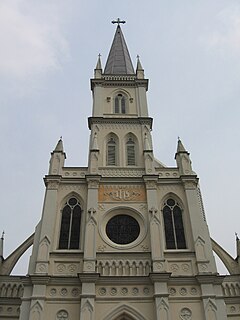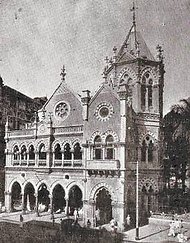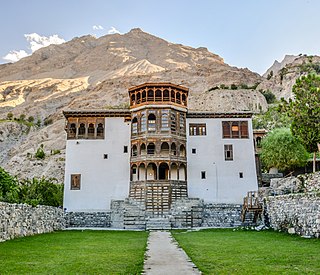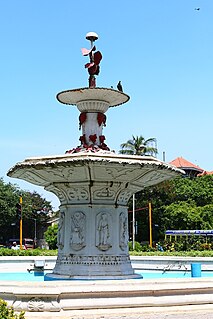 W
WThe Ascension Cathedral, also known as Zenkov Cathedral, is a Russian Orthodox cathedral located in Panfilov Park in Almaty, Kazakhstan. Completed in 1907, the cathedral is made out of wood but without nails. Its height is 56 meters tall, and is claimed to be the second tallest wooden building in the world.
 W
WBaltit Fort is a fort in the Hunza valley, near the town of Karimabad, in the Gilgit-Baltistan region of northern Pakistan. Founded in the 8th century CE, it has been on the UNESCO World Heritage Tentative list since 2004.
 W
WBomanjee Hormarjee Wadia Clock Tower is a heritage structure in Fort, Mumbai, India, that was erected in 1882 using public funds as a token of appreciation for Bomanjee Hormarjee Wadi, a Parsi philanthropist who had contributed to the cause of education in the city. He was a member of the Bombay Native Education Society and on the board of Elphinstone Institution. He died on 3 July, 1862.
 W
WBonython Hall is the "great hall" of the University of Adelaide, located in the university grounds and facing North Terrace, Adelaide. The building is on the now-defunct Register of the National Estate and the South Australian Heritage Register. It is primarily used for University graduation ceremonies, examinations, expositions and public lectures and meetings likely to draw large audiences.
 W
WCaldwell House was a historical building designed and built by George Drumgoole Coleman from 1840 to 1841 in Singapore. It was the oldest building of the CHIJMES complex since 1854. It currently serves as a venue known as the Alcove at Caldwell House for wedding functions.
 W
WThe Cathedral of the Immaculate Conception is a late 19th-century English Gothic revival church that serves as the cathedral of the Roman Catholic Diocese of Hong Kong. It is located in the Mid-Levels area of the city at 16 Caine Road.
 W
WThe Central Ordnance Munitions Depot was constructed in the late 1930s by British for the World War II to combat the Japanese Invasion as well as to store arms and ammunition for the defence of Hong Kong. The British used "Little Hong Kong", name for the fishing village town of Aberdeen, as a "code name" to refer to the military site and therefore confuse Japanese spies in the local community before the Japanese invasion.
 W
WCHIJMES is a historic building complex in Singapore, which began life as a Catholic convent known as the Convent of the Holy Infant Jesus (CHIJ). The complex is located at Victoria Street in the Downtown Core, within the Central Area, Singapore's central business district.
 W
WCHIJMES Hall was the former Convent of the Holy Infant Jesus Chapel located at the CHIJMES complex in Singapore. The former chapel was designed by Father Charles Benedict Nain, it currently serves as a function hall venue for weddings and corporate events.
 W
WChrist Church in Byculla, Mumbai, is affiliated to the Church of North India and was built in 1833 as an Anglican church. The church's establishment has been the subject of a myth that it was built to suit the convenience of the Governor of Bombay, Mountstuart Elphinstone, who reportedly had to earlier travel from his central Bombay residence in Parel to St Thomas Cathedral in South Bombay. Elphinstone had already left India in 1829. The church was, in fact, built during the governorship of John FitzGibbon, 2nd Earl of Clare, who laid the foundation stone in July, 1832.
 W
WThe Doon School is an all-boys selective boarding school in Dehradun, Uttarakhand, India, which was established in 1935. It was envisioned by Satish Ranjan Das, a Kolkata lawyer, who prevised a school modelled on the British public school, but conscious of Indian ambitions and desires. The school admitted its first pupils on 10 September 1935, and formally opened on 27 October 1935, with Lord Willingdon presiding over the ceremony. The school's first headmaster was Arthur E. Foot, an Englishman who had spent nine years as a science master at Eton College, England.
 W
WGloria Church or Our Lady of Glory Church is built in 1911-13 on one of the oldest Roman Catholic church sites in Mumbai; its predecessor was built by the Portuguese Franciscans in 1632. The church is situated in Byculla, Mumbai. In 2019, the restoration project for the church received the Award of Merit under the UNESCO Asia-Pacific Awards for Cultural Heritage Conservation.
 W
WThe J. N. Petit Library is a membership library in a Grade II heritage structure in Fort, Mumbai. It was founded in 1898 by a group of Parsi students studying at Elphinstone College. Membership is open to residents of Mumbai.
 W
WKhaplu Palace, locally known as Yabgo Khar, is an old fort and palace located in Khaplu, a city in Gilgit−Baltistan, Pakistan. The palace, considered an architectural heritage site and a significant tourist attraction, was built in the mid-19th century to replace an earlier-dated fort located nearby. It served as a royal residence for the Raja of Khaplu.
 W
WThe Sri Ranganathaswamy Temple is a Hindu temple dedicated to Ranganatha, a form of the Supreme God, Maha Vishnu, located in Srirangam, Tiruchirapalli, Tamil Nadu, India. Constructed in the Dravidian architectural style, the temple is glorified by Alvars in their Divya Prabhanda and has the unique distinction of being the foremost among the 108 Divya Desams dedicated to The Supreme God Vishnu.
 W
WSt Andrew's Church is located at 138 Nathan Road, Kowloon, Hong Kong. It is a church of the Anglican Province of Hong Kong and in the Diocese of Western Kowloon. It is the oldest English speaking Protestant church in Kowloon. While St Andrew's commenced its life as a church for the expatriate community, it is now an international church with 90% of those attending considering Hong Kong as their home.
 W
WSt. Thomas Cathedral, Mumbai, is the cathedral church of the Diocese of Mumbai of the Church of North India. Named in honour of Saint Thomas the Apostle, the Cathedral is located in the historic centre of Mumbai, Horniman Circle, and is close to Flora Fountain and Bombay House. The 300-year-old church is oldest church in Mumbai and is controlled by the Cathedral and John Connon School.
 W
WThe Suffolk House refers to two early residences built on the same site located some four miles west of George Town, Penang, Malaysia. Located on the banks of the Air Itam River, the earliest of the two buildings is notable for having served as the residence of Francis Light, the founder of the first British settlement on Penang. Following Light's death in 1794, and with Penang becoming the fourth presidency of India in 1805, a newer Suffolk House replaced the original house, assuming multiple roles before it was later neglected and subsequently restored.
 W
WAishwarya Tipnis is an Indian architect ,educator and heritage conservationist, whose eponymous practice Aishwarya Tipnis Architects focuses on heritage conservation of neglected monuments and significant buildings of India. In 2015, her work on the century-old Main Building of The Doon School received the Honourable Mention under the UNESCO Asia-Pacific Awards for Cultural Heritage Conservation. In 2016, the firm's restoration work on the walls and bastions of the 18th-century Mahidpur Fort, in Madhya Pradesh, was given the Award of Merit under the UNESCO Asia Pacific Heritage Awards. In 2018, she became the youngest architect to be appointed the Chevalier de l'Ordre des Arts et des Lettres by the French government for her preservation work of French heritage in India, particularly Chandernagore in West Bengal. Tipnis was part of the UNESCO Expert Team for preparing the Comprehensive Conservation Plan for the Darjeeling Himalayan Railway, a UNESCO World Heritage Site. She has been recognised as a Global Cultural Leader by the European Union in 2016.
 W
WVadakkumnathan Temple is an ancient Hindu temple dedicated to Shiva at city of Thrissur, of Kerala state in India. This temple is a classical example of the architectural style of Kerala and has one monumental tower on each of the four sides in addition to a kuttambalam. Mural paintings depicting various scenes from the Mahabharata can be seen inside the temple. The shrines and the Kuttambalam display vignettes carved in wood. The temple, along with the mural paintings, has been declared as a National Monument by India under the AMASR Act. According to popular local lore, this is the first temple built by Parasurama, the sixth avatara of Vishnu. Thekkinkadu Maidan, encircling the Vadakkunnathan Temple, is the main venue of the renowned Thrissur Pooram festival.
 W
WWellington Fountain is a listed heritage structure in front of Maharashtra Police Headquarters at Shyamaprasad Mukherjee Chowk in Fort, Mumbai,which is part of Mumbai's Victorian ensemble that is a UNESCO World Heritage Site. It was erected in 1865 to commemorate the visits of Arthur Wellesley, 1st Duke of Wellington, who came to India in 1801 and 1804.
 W
WThe Yokohama Red Brick Warehouse is a historical building that is used as a complex that includes a shopping mall, banquet hall, and event venues. The complex, officially known as the Newport Pier Bonded Warehouse , was originally used as customs buildings, and has two sections: Warehouse No.1 and No.2. It is operated by Yokohama Akarenga Co. Ltd., and located at the Port of Yokohama in Naka-ku, Yokohama, Kanagawa, Japan.